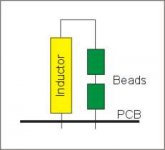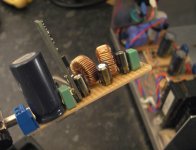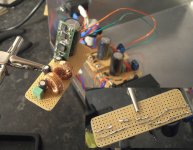philpoole said:
I think I'd err to shielded cat 5, as its half the price, and you can get solid core, but this stuff is far prettier.
Worth having I think.
Will you use it for anything else? Or just the power supply?
I want the strandedness of it, for easy soldering and not snapping. Just digital power supplies. When that's all done it's analogue power supplies...
I'm building a dedicated PSU for my TDA1541 DAC (I took a different path when my CD63 died). It will be an onboard PSU, so toroids are quite handy. However, even in an external PSU, I think toroids are better. They have lower reluctance and are more efficient IMO. They also vibrate less, so are quieter.
Its very low current really (unless I do something silly).
I like toroids. Maybe I'm biased, I don't know. I have also used EI transformers with great success too (i.e I had a non KI CD63 and that seemed okay). And it looks like you'll have yours completely shielded, so stray EMI shouldn't be an issue.
Stranded cable does have its benefits. I tend to use solid core internally. Thinking about it, I use stranded for external connections as well. Maybe I'm not awake? It is likely.
Cheers,
Phil
Its very low current really (unless I do something silly).
I like toroids. Maybe I'm biased, I don't know. I have also used EI transformers with great success too (i.e I had a non KI CD63 and that seemed okay). And it looks like you'll have yours completely shielded, so stray EMI shouldn't be an issue.
Stranded cable does have its benefits. I tend to use solid core internally. Thinking about it, I use stranded for external connections as well. Maybe I'm not awake? It is likely.
Cheers,
Phil
Allan,
I know that CAT5 is good and useful to have those grounds. I'm opting for something different so I can cram more psu rail feeds into an 8-pin DIN. Also I don't like working with solid core (even though I know it's better).
Groundloops, yep, I'll be listening for the hummm. If it's a problem I'll connect earth to utility only at cdp end. Earth at psu end will be for safety/chassis only.
Phil,
I've sometimes read toroids are bad for digital as they allow HF noise through, whereas old-style ones remove it, which is a bonus. It's also often said toroids are not the best for sound. It's probably good in the KI because a) it's a nice one, b) it's got headroom and many separate windings and c) it's close to sensitive parts. I'll be happy with my £2 transformer from Ebay, and it may join a toroid or two yet, I've been collecting them!!
You seem awake
Simon
I know that CAT5 is good and useful to have those grounds. I'm opting for something different so I can cram more psu rail feeds into an 8-pin DIN. Also I don't like working with solid core (even though I know it's better).
Groundloops, yep, I'll be listening for the hummm. If it's a problem I'll connect earth to utility only at cdp end. Earth at psu end will be for safety/chassis only.
Phil,
I've sometimes read toroids are bad for digital as they allow HF noise through, whereas old-style ones remove it, which is a bonus. It's also often said toroids are not the best for sound. It's probably good in the KI because a) it's a nice one, b) it's got headroom and many separate windings and c) it's close to sensitive parts. I'll be happy with my £2 transformer from Ebay, and it may join a toroid or two yet, I've been collecting them!!
You seem awake
Simon
SimontY said:Allan,
I know that CAT5 is good and useful to have those grounds. I'm opting for something different so I can cram more psu rail feeds into an 8-pin DIN. Also I don't like working with solid core (even though I know it's better).
Groundloops, yep, I'll be listening for the hummm. If it's a problem I'll connect earth to utility only at cdp end. Earth at psu end will be for safety/chassis only.
Phil,
I've sometimes read toroids are bad for digital as they allow HF noise through, whereas old-style ones remove it, which is a bonus. It's also often said toroids are not the best for sound. It's probably good in the KI because a) it's a nice one, b) it's got headroom and many separate windings and c) it's close to sensitive parts. I'll be happy with my £2 transformer from Ebay, and it may join a toroid or two yet, I've been collecting them!!
You seem awake
Simon
my cat5e is not solid core, in fact most cat5e is stranded.
earth
still need a star grd, similar to Brent's
this is where the main earth is connected
will also need psu cabinet and cdp metal at same potiental,
run an earth earth trsp between the two cases.
allan
awpagan said:my cat5e is not solid core, in fact most cat5e is stranded.
earth
still need a star grd, similar to Brent's
this is where the main earth is connected
will also need psu cabinet and cdp metal at same potiental,
run an earth earth trsp between the two cases.
allan
Interestingly, I've only ever seen solid core CAT5. Farnell, for example, have all sorts available though.
My CDP has a star ground. I'll be using it for these.
SimontY said:
Interestingly, I've only ever seen solid core CAT5. Farnell, for example, have all sorts available though.
My CDP has a star ground. I'll be using it for these.
stranded
simple cat5e "patch" cable.
allan
Phil,
I've sometimes read toroids are bad for digital as they allow HF noise through, whereas old-style ones remove it, which is a bonus. It's also often said toroids are not the best for sound. It's probably good in the KI because a) it's a nice one, b) it's got headroom and many separate windings and c) it's close to sensitive parts. I'll be happy with my £2 transformer from Ebay, and it may join a toroid or two yet, I've been collecting them!!
You seem awake
Simon
No wonder you're happy with £2 transformers of Ebay!
Most toroids are nice aren't they?
I'm sure, for these scenarios, as long as they're specified correctly, most reasonably well built transformer will do.
SimontY said:I'm currently searching for a good 8-pin DIN plug and socket combination to use with my external psu. There are some lovely screw-down ones made by Lumberg on Farnell (codes 808271 and 1193062)
...
Only accepts up to 6mm cable though, so getting the wire right will be tricky. The pins only take up to 0.34mm2, again, a bit tight.
Why is nobody else doing external psus? Now I see why....!
Simon
Hi Simon,
Have you though about using XLR's? They can fit bigger cable AFAIK and are a bit more chunky compared to the DIN connectors. OTOH you don't need much current, so the cross-section of CAT-5 will probably be ok.
Ray.
Interesting AD news
Just saw this on the AD website, a new dual opamp: the AD8599. Not available yet, but could be an interesting candidate.
Ray
Just saw this on the AD website, a new dual opamp: the AD8599. Not available yet, but could be an interesting candidate.
Ray
Hi.
For anyone contemplating building a power conditioner, the link below is interesting reading.
Andy
http://www.diyaudio.com/forums/show...015&perpage=10&highlight=felicia&pagenumber=1
For anyone contemplating building a power conditioner, the link below is interesting reading.
Andy
http://www.diyaudio.com/forums/show...015&perpage=10&highlight=felicia&pagenumber=1
As an alternative to shorting R613-616, what is the consensus on using a choke as proposed by Thorsten?
"Having had such success with LC decoupling in the Digital Department (see below), I also introduced it in the analog Circuit. Here R613 to R616 and R 651 to R654 where replaced with 2,2mH (If I can read the coding correctly - they where salvaged from some board) Axial Inductors with a measured DC of 1.5 Ohm. This is a much better solution than just shortening these Resistors out as it is suggested by a number of People."
If so, what brands of choke are good quality?
"Having had such success with LC decoupling in the Digital Department (see below), I also introduced it in the analog Circuit. Here R613 to R616 and R 651 to R654 where replaced with 2,2mH (If I can read the coding correctly - they where salvaged from some board) Axial Inductors with a measured DC of 1.5 Ohm. This is a much better solution than just shortening these Resistors out as it is suggested by a number of People."
If so, what brands of choke are good quality?
YoungSC said:As an alternative to shorting R613-616, what is the consensus on using a choke as proposed by Thorsten?
"Having had such success with LC decoupling in the Digital Department (see below), I also introduced it in the analog Circuit. Here R613 to R616 and R 651 to R654 where replaced with 2,2mH (If I can read the coding correctly - they where salvaged from some board) Axial Inductors with a measured DC of 1.5 Ohm. This is a much better solution than just shortening these Resistors out as it is suggested by a number of People."
If so, what brands of choke are good quality?
Hi.
The use of chokes in the power lines is not new.
The Philips CD104 has plenty.!
I used 1mH chokes from Maplins.
I have also used Ferrite beads on jumpers.
Andy
poynton said:Hi.
For anyone contemplating building a power conditioner, the link below is interesting reading.
Andy
http://www.diyaudio.com/forums/show...015&perpage=10&highlight=felicia&pagenumber=1
Hi Andy,
Cool link! Another nice approach to balanced thinking. It definately works for my set!
YoungSC said:As an alternative to shorting R613-616, what is the consensus on using a choke as proposed by Thorsten?
...
If so, what brands of choke are good quality?
The idea is that a choke should provide better RF noise suppression compared to a wire link or a resistor, because of the higher impedance. A bigger resistor will do that too, but that will give too much DC loss. I generally pick a choke in the 220...1000uH range that has about half the DC resistance than the original resistor. That way, you minimize DC loss and add impedance at the same time. Standard axial chokes (like EPCOS) will do fine, and if you mount them vertically you can add a ferrite or two.
Ray
Attachments
6h5c said:
Hi Simon,
Have you though about using XLR's? They can fit bigger cable AFAIK and are a bit more chunky compared to the DIN connectors. OTOH you don't need much current, so the cross-section of CAT-5 will probably be ok.
Ray.
Much higher power ratings and they only go up to 7 pole. On balance the DIN seems just as suitable and I have found very nice looking ones. For an external amp PSU, the XLR is the way to go it would appear... Like Musical Fidelity XA-2 (lovely amp that). I will use XLR on my next power amp.
Simon
6h5c said:Standard axial chokes (loke EPCOS) will do fine, and if you mount them vertically you can add a ferrite or two.
Exactly what I did on my player and it seemed useful. I glue-gunned them and that was a bad move...they can get in the way of other parts!
Good evening all,
I just made this to go in my player to feed the clock, it's 2200uF Pana FC, 1uF film, 12v Audiocom Super-reg, 33uF FC, 0.1mH, 33uF, 0.1mH, 33uF, 1uF. It's fed from one of the psus as shown previously. It works, which is nice for a change. Just need to do the 5v one then I can have a listening test!!
Simon (getting slightly excited..)
I just made this to go in my player to feed the clock, it's 2200uF Pana FC, 1uF film, 12v Audiocom Super-reg, 33uF FC, 0.1mH, 33uF, 0.1mH, 33uF, 1uF. It's fed from one of the psus as shown previously. It works, which is nice for a change. Just need to do the 5v one then I can have a listening test!!
Simon (getting slightly excited..)
Attachments
Here's another shot, with an inset to show the back, to see how it's wired. The ferrite cored inductors/chokes measure 0.1mH on my basic LCR meter, and about 4ohms DCR on my good multimeter. I do hope they're appropriate. This clock psu is vastly more elaborate (and more expensive) than the current setup. Can't wait to hear what it will do!
Time to get on with the next one now, and to eat curry...
Simon
Time to get on with the next one now, and to eat curry...
Simon
Attachments
By using a choke instead of a ferrite bead, you add 1-2 Ohms of resistance at low frequencies and more resistance at higher ones. This strangles your audible bass performance and dynamics like the stock resistors.YoungSC said:As an alternative to shorting R613-616, what is the consensus on using a choke as proposed by Thorsten?
Using a fancy regulator and additional power supply become nearly worthless once you choke it. You only get the lower noise performance of the fancy regulator, not the extra bass and dynamics from having a lower ESR regulator and power supply. The best place for a choke is after the power transformer as Ayre and Musical Fidelity do to filter mains noise.
In the digital circuits there is no such audible penalty for using a resistor or choke, and only benefits. You do want to keep the leads short. The whole idea is to not be a noise antenna broadcasting. Radiated noise is also lessened by a low ESR electrolytic and low ESR bypass (ceramic) bypass at the digital chip (noise source) that is decoupled from the power rail by the choke. Noise on the grounds is a whole other ball of wax and ferrite beads on jumpers connecting grounds are reported to help according to some modifiers. Noise is more effectively tamed at its sources than where it might turn up. That's another level or two of mods after the basic ones and best done with a 'scope.
If you want to not just jumper at R613-R616, use just a ferrite bead or two around a jumper wire. The stock 12 volt regulators have high ESR at DC to hardly much above bass frequencies and extra Ohms at 1 MHz won't matter. Better regulators have lower impedence at DC and also up to high audible frequencies, gaining you better microdynamics that the bypass caps alone can't provide.
Jumpering R613-R616 is the quick, easy, and effective mod for anyone just getting started on a CD63 et al.. Doing it gives immediate, positive results to motivate anyone to go ahead and do some more modifications. Its FUN to make stuff sound better and added bass and dynamics are all the more fun.
Save getting bogged down in theory and minutae for after several levels of modification. Reworking past changes into newer, grander schemes are pert of the modification process. Down the line you may prefer chokes and fortunately they will be quick and easy to fit without undoing massive prior work. In other words, enough w*nking - just try shorting accross those resistors!
- Home
- Source & Line
- Digital Source
- Marantz CD63 & CD67 mods list


